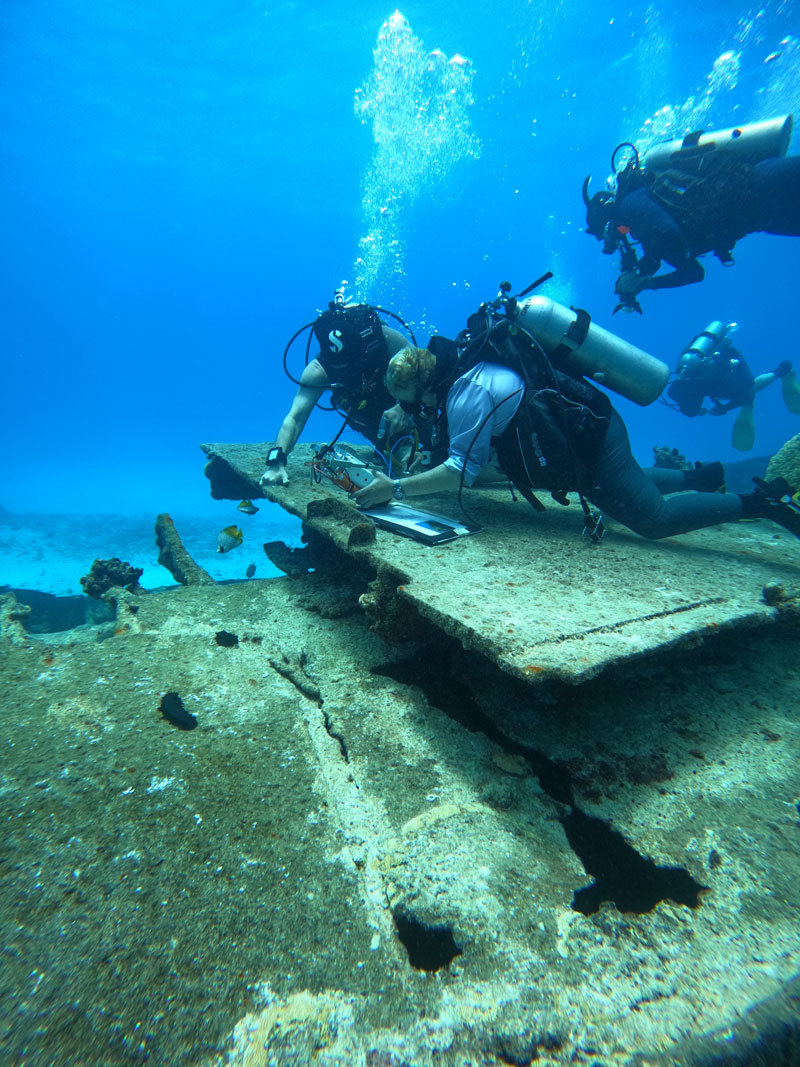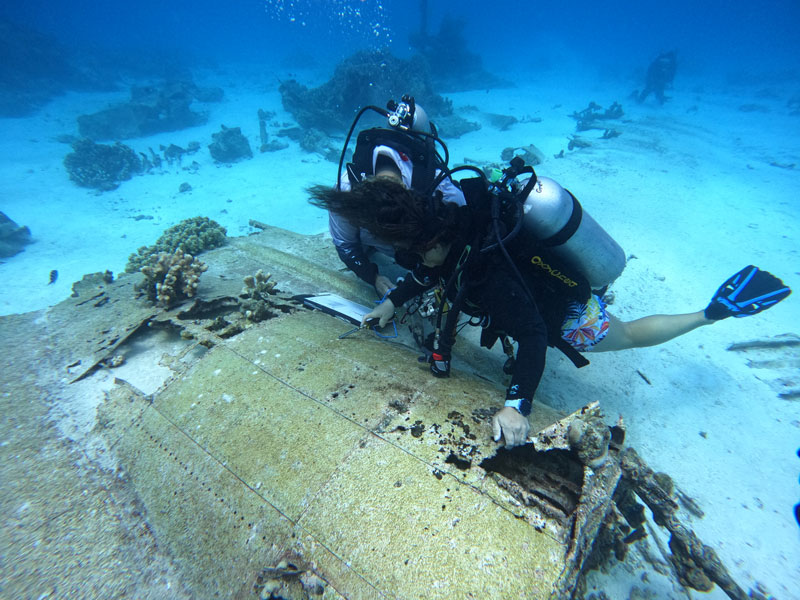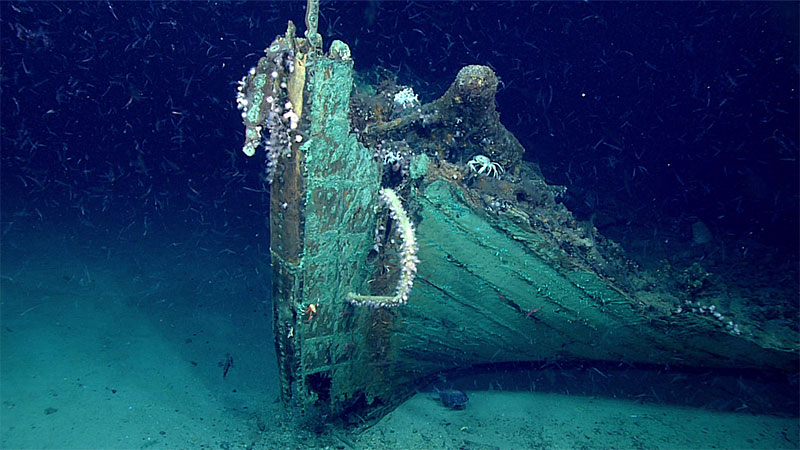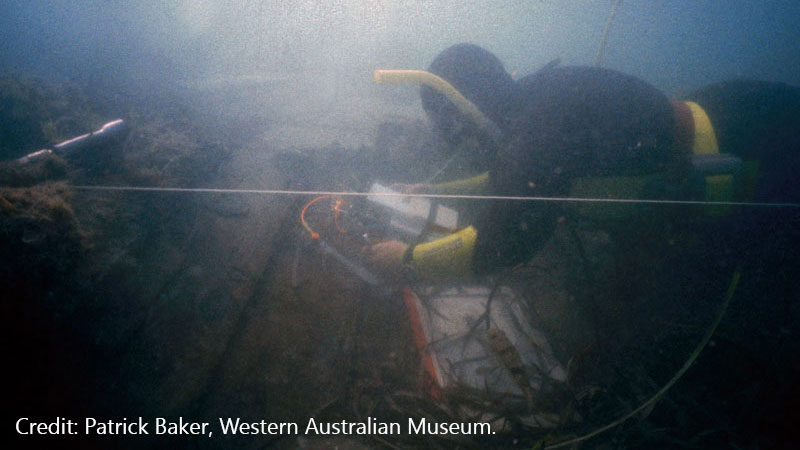Conservation Surveys
In situ conservation surveys are important instruments in the maritime heritage exploration toolkit. Researchers use them to understand the current status and levels of preservation of maritime heritage sites such as shipwrecks, sunken aircraft, and other submerged cultural artifacts.

Divers using a small drill to measure corrosion on the wreck of the Japanese freighter Shoan Maru in the waters off Saipan in the Northern Mariana Islands during the Exploring Deepwater World War II Battlefields in the Pacific Using Emerging Technologies expedition. Image courtesy of Ships of Discovery. Download larger version (jpg, 12.8 MB).
What’s Involved In a Conservation Survey?
Archaeologists and conservation scientists (with training in chemistry) often work together on conservation surveys, collecting data and information about a site and its environment to better understand site degradation, threats to preservation, and recommendations for site protection and management. Conservation surveys are conducted in situ (meaning where a site rests on the seafloor) to avoid disturbing and damaging the site and associated artifacts and marine life. They typically include:
- Visually surveying a site with diving equipment, remotely operated vehicles, and/or autonomous underwater vehicles with video and still cameras and documenting site composition, characteristics of exposed artifacts (e.g., type, material, apparent condition, degree of preservation, distribution), extent and seasonality of site exposure to natural events such as storms, past and potential human impacts (e.g., salvage, pollution, marine debris), and the presence of plants, animals, and other organisms.
- Collecting environmental data with oceanographic instruments to document a site’s depth, sediment type, visibility, water temperature, salinity, pH, dissolved oxygen content, currents, and geophysical characteristics, including bathymetry.
- Consulting historical records about site conditions over time (e.g., surface weather and tides).
Conservation surveys of sites with significant metal artifacts (e.g., iron and steel-hulled shipwrecks, cannons, anchors, and aluminum aircraft) also involve a corrosion survey. This entails determining the corrosion potential of the site’s metal components and measuring the pH of the metal surfaces and the extent and depth of corrosion and concretions (hard masses made up of a combination of corrosion products and biological and mineral deposits).
Collectively, this work results in a conservation assessment of the site. This assessment describes a site’s condition and overall stability and the environmental, chemical, physical, and human factors affecting it along with the rate of corrosion and concretion build up (if applicable) and how they work together to influence or deter degradation.
Why Are Conservation Surveys Important?
Maritime heritage sites are under constant threat by their environment (especially sites in shallow saltwater) as well as by humans. Researchers use conservation surveys:
- To help them understand a maritime heritage site’s level of preservation,
- To establish a baseline for future site conservation and archaeological monitoring,
- To inform site preservation priorities, and
- To guide development of monitoring and management plans.
Maritime heritage sites help us better understand how humans have interacted with the ocean. In addition, some sites have significance beyond their historical and archaeological worth. For example:
- Sunken WWII ships can pose environmental threats. They hold oil, fuel, and/or munitions that could create an environmental disaster if they collapsed.
- Dive tourism on WWII sites is a large part of some small Pacific Island economies. While an important use, diver impacts are a real concern.
- Shipwrecks often become part of their environment, providing habitat for a variety of organisms.

Divers measuring corrosion on the aluminum wing of a H8K Kawanishi Japanese seaplane, code named "Emily," in the waters off Saipan in the Northern Mariana Islands during the Exploring Deepwater World War II Battlefields in the Pacific Using Emerging Technologies expedition. Image courtesy of Ships of Discovery. Download larger version (jpg, 12.2 MB).
Through conservation surveys and a thorough understanding of a site’s history, threats, and uses, archaeologists and resource managers can make informed decisions about what sites to preserve, how best to preserve them, preferably in situ as promoted by the United Nations Educational, Scientific and Cultural Organization’s Convention on Underwater Cultural Heritage , (e.g., restricting diver access, reburial of sites), and/or how to remove their threats (if necessary).
By Jennifer McKinnon, Ships of Discovery/Department of History, East Carolina University
Published May 25, 2023
Relevant Expedition: Exploring Deepwater World War II Battlefields in the Pacific Using Emerging Technologies


